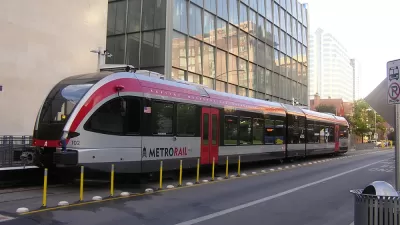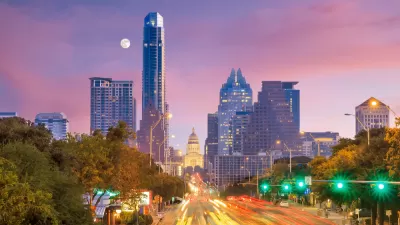A light rail bridge proposed for Lady Bird Lake, still pre-design, is causing controversies about whether adding buses to the bridge would be too dangerous for the other non-automotive modes.
Nathan Bernier reports for KUT about a key question among many in Austin's $7 billion Project Connect public transit expansion plan: Should Capital Metro buses be allowed to cross a light rail bridge planned to cross Lady Bird Lake?
"The question has been a hot topic among close observers of the process and recently emerged at a public design workshop hosted by the Austin Transit Partnership (ATP), the government corporation created to oversee the $7 billion Project Connect transit expansion," writes Bernier. The debate also spilled over to a contentious meeting of the Urban Transportation Commission (UTC), according to Bernier.
UTC Commissioner Samuel Franco is quoted in the article saying that blocking buses from the bridge would perpetuate the racist history of planning Austin (Austin's 1928 Master Plan forced Black residents to the city's East Side, as noted by Bernier in the article).
ATP staffers have claimed that buses would create conflicts on a bridge designed to accommodate pedestrians, cyclists, and light rail. "In particular, [Peter Mullan, ATP chief of architecture and urban design] said, he wasn't sure how buses could be incorporated in an underground tunnel on the north side of the lake because it's so constrained," reports Bernier.
The decision about whether to include buses on the bridge will have to wait for a competitive bid process for the bridge design. "The ATP is planning to issue a request in January for engineering firms worldwide to compete for the contract to design the bridge," according to Bernier.
FULL STORY: Should buses be allowed on a new light-rail bridge over Lady Bird Lake?

Study: Maui’s Plan to Convert Vacation Rentals to Long-Term Housing Could Cause Nearly $1 Billion Economic Loss
The plan would reduce visitor accommodation by 25,% resulting in 1,900 jobs lost.

North Texas Transit Leaders Tout Benefits of TOD for Growing Region
At a summit focused on transit-oriented development, policymakers discussed how North Texas’ expanded light rail system can serve as a tool for economic growth.

Why Should We Subsidize Public Transportation?
Many public transit agencies face financial stress due to rising costs, declining fare revenue, and declining subsidies. Transit advocates must provide a strong business case for increasing public transit funding.

How Community Science Connects People, Parks, and Biodiversity
Community science engages people of all backgrounds in documenting local biodiversity, strengthening connections to nature, and contributing to global efforts like the City Nature Challenge to build a more inclusive and resilient future.

Alabama: Trump Terminates Settlements for Black Communities Harmed By Raw Sewage
Trump deemed the landmark civil rights agreement “illegal DEI and environmental justice policy.”

Dear Tesla Driver: “It’s not You, It’s Him.”
Amidst a booming bumper sticker industry, one writer offers solace to those asking, “Does this car make me look fascist?”
Urban Design for Planners 1: Software Tools
This six-course series explores essential urban design concepts using open source software and equips planners with the tools they need to participate fully in the urban design process.
Planning for Universal Design
Learn the tools for implementing Universal Design in planning regulations.
City of Santa Clarita
Ascent Environmental
Institute for Housing and Urban Development Studies (IHS)
City of Grandview
Harvard GSD Executive Education
Toledo-Lucas County Plan Commissions
Salt Lake City
NYU Wagner Graduate School of Public Service





























